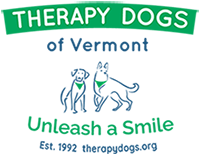– Deb Helfrich, Therapy Dogs of Vermont
It’s been a dreadful day. The car wouldn’t start. Traffic made you late. You spilled coffee on your new pants. The boss moved your deadline UP by a week. Full of frustration, you throw the front door open…and there is YOUR dog. Her entire body wags. She rolls on her back for a tummy rub. You can’t help but smile. As you touch her soft fur and feel the warmth of her body, thoughts of stained pants and looming deadlines slip away.
Think about the capacity our own pets have to ease stress, make us happy, offer comfort. Apply this to elders in nursing homes, patients in hospitals, children in day cares—this is the heart of canine therapy.
Canine therapy works toward the emotional health of people in a wide variety of settings. In fact, elder care facilities may be one of the most frequented types of places for therapy dog vis its. Visiting with elders can be a wonderful experience for both dog and handler! For example, the highlight of my week is visit- ing my friends at Starr Farm Nursing Center. I’m sure any of our TDV members can tell you a heartwarming story or two about the places they visit and the people they meet. It is a joy to me when my dog lights up the face of an elder who perhaps doesn’t get many visitors, and I enjoy listening to the wonderful stories elders carry with them. And, the special moments when I can comfort an elder who may be depressed, disoriented, anxious, afraid, or ill are ones that simply make everything worth while; these are the moments when the magical interaction between animal and human is unmistakable. Tears dry. Frowns become smiles. Inactive hands caress soft fur. Silence becomes a conversation whispered softly in a dog’s ear.
During visits, dogs may play ball with a patient, sit to be patted, do a few tricks, or take walks with those who are able. For a bedridden patient, a dog might hop on the bed and rest quietly with him or her. Sometimes, all a dog can do is be there for someone to look at. There are all sorts of activities and levels of interaction possible— based on whatever the person needs at the time.
DOGS CAN HAVE A PROFOUND ABILITY TO TOUCH AND ENGAGE PEOPLE. FOR EXAMPLE, DURING THEIR VISITS, THERAPY DOGS ROUTINELY:
- Bring joy and laughter to institutions that might feel sterile, cold, and frightening.
- Give something to do, talk, and think about other than the illness, difficulty, or problem.
- Help people cope with illness, loss, depression, and loneliness.
- Stimulate the senses, facilitating exercise and activity.
- Encourage communication and break the ice.
- Provide a source of touch and affiliation.
- Boost morale and lower stress levels.
Therapy Dogs of Vermont (TDV) is an all-volunteer, non-profit organization of well-mannered, sweettempered, people-loving dogs and their handlers. Our handler/canine teams work toward the emotional health of people in a variety of settings such as hospitals and other health-related venues, nursing and retirement homes, child and adult day care centers, correctional facilities, and schools. All dogs are certified and insured. For more information about becoming a certified therapy dog team, to request therapy dog visits, or to make a donation, please email us at admin@therapydogs.org or visit our website: therapydogs.org
